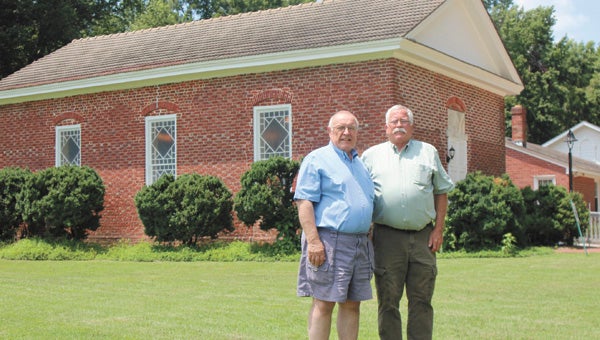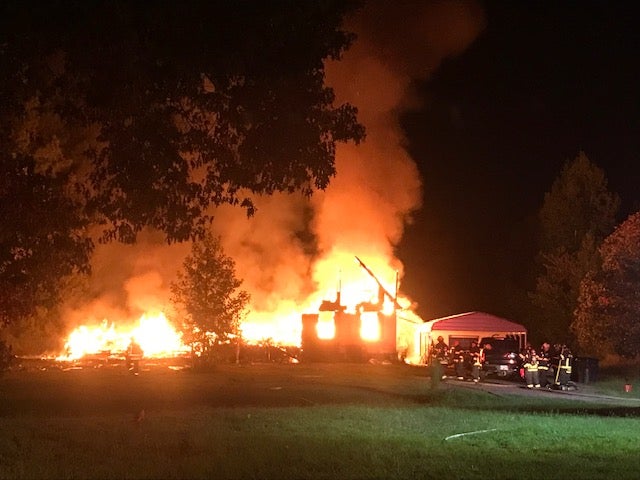Solid foundations, leaky roof
Published 9:47 pm Monday, July 14, 2014

Philip Ford and Thomas Dawson stand in front of Suffolk’s Glebe Episcopal Church. The historic building needs a new roof, which won’t come cheap, and they’re working to raise money from the community.
Of the 250 churches built in colonial America, Glebe Episcopal near Driver is one of fewer than 50 still standing.
That’s Thomas Dawson’s reckoning, and he has good reason to be touting Glebe’s historical significance.
Glebe needs a new roof, and the chair of its Building and Preservation Committee knows such things don’t come cheap for a structure built in 1738.
“It’s leaking — water has come down into the church,” Dawson said.
Inside, stains on the expensive tongue-and-groove wood paneling provide evidence of the leak.
Dawson describes three viable options for replacing the 100-odd-year-old roof, which consists of concrete tiles laid directly over cedar shakes, while no one knows if yet more layers exist.
“We have narrowed it down to artificial cedar shake, or we could go artificial slate or a real slate roof,” he said.
Glebe being on the National Register of Historic Places, a cheaper roof isn’t an option.
So Glebe is embarking on a mission to raise about $75,000 for an authentic slate roof and to fix the soffits, trim and cornice, Dawson said. Hidden damage could raise the cost.
Slate would last 100 years versus 50 years for cedar shakes, he said, and it would be more appropriate for the building. “You should put a roof on the church that would be the same as when it was built,” he said.
The current roof was installed in about 1900, said Philip Ford, a Glebe trustee. “There was a fire here, so a lot of the records have been lost,” but there are thought to have been several different roofs over the centuries, he added.
Ford says the concrete tiles there now, known as Norfolk tiles, are prone to vertical cracking. And the material beneath is rotting.
What’s more, Ford said, the building does not have an attic, meaning the valuable interior paneling is in close proximity to that rot.
“It’s not leaking at the moment, but then, on the other hand, you don’t know if water is seeping in,” he said.
Dawson says Glebe has $10,000 toward the $75,000 roof, an estimate that also includes 3/4-inch plywood sub roof and a “fiberglass paper” water barrier.
“The rest of it would have to come from grants, contributions and fundraisers,” he said.
A challenge for the church is its declining congregation: It’s been decreasing about 10 percent a year, Dawson said, and currently stands at 136 members. “All of our fixed costs have not gone down, but our congregation keeps shrinking. Fewer people have to make up the difference.”
Many older churches have large endowments to help offset this effect, but not Glebe. In fact, the church has started a “mortgage-burning fund” to pay down debt it took on to build a new hall in 2003.
“We ask the people in the congregation to put in an envelope what they feel they can afford,” Dawson said.
“In three years we have decreased the mortgage by $45,000. It’s significant when you’re talking about $300,000.”
Ford added, “When we pay off the new hall, we are going to burn the mortgage — literally.”
They’ve inquired about various grants, Dawson said, only to learn so far that a church roof doesn’t fit the grant’s guidelines.
He hopes area philanthropists will recognize the Episcopal Church building’s cultural and historical significance to Suffolk, but meanwhile they’re also planning fundraisers.
Weather permitting, Cars and Coffee will be held on the church grounds, 4400 Nansemond Parkway, on July 26 and Aug. 16 from 8 to 10 a.m., with coffee provided in the parish hall.
Sausage biscuits and doughnuts will be available for purchase, and 50/50 raffle is planned. All proceeds go to the Building and Preservation Fund — specially formed for the new roof, Dawson said.
Folks are encouraged to bring their favorite car — classic or otherwise — and share car stories while touring the colonial church.
Meanwhile, an ABC (attic-basement-closet) yard sale is on the books for September, and Dawson said he’s updating the church’s website and Facebook page to communicate the call for assistance.
“The idea of all these things is fellowship, to reach out into the community, and to raise money,” Dawson said.






